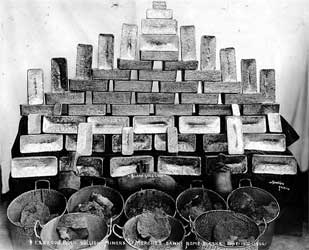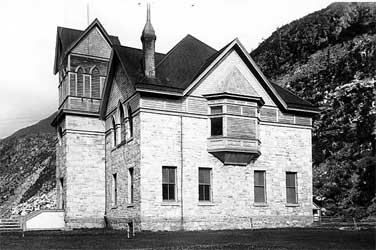Frank H. Nowell Photographs of Alaska, 1901-1909
Sample Searches
More Frank Nowell Photographs
Alaska Yukon Pacific Exposition
Indians of the Pacific Northwest
Other Resources
Photographer Frank Nowell spent a portion of his career in Nome, Alaska documenting the events after the gold rush of 1900. The photographs here present a picture of the towns and business enterprises as they developed during this early stage of Alaskan history. He also chronicled the local native populations with special focus on Eskimo life and customs.
Born on February 19, 1864 in Portsmouth, New Hampshire, Frank Nowell was one of Thomas and Lydia Ham Nowell's six sons. He spent his childhood growing up on the east coast before moving to the plains of Nebraska to work on the family ranch, where Buffalo Bill Cody's Wild West Show once spent a winter. In 1886, he turned north to seek his fortune in Alaska, where his father had already moved. Shipping out on the S.S. Ancon, Frank planned to start the first dairy ranch in Alaska. Subsequently, he ventured into the mining business in the vicinity of Juneau and Silver Bow, and eventually joined his father's mining operation on Douglas Island.
His father, Thomas Nowell, was an interesting man in his own right, and is historically significant because he was the first delegate from Alaska to the Republican National Convention of 1892 in Minneapolis. Originally involved in the shoe business, Thomas speculated in some mining ventures which resulted in the formation of several mining and milling companies: Berner's Bay Mining and Milling Company, Ophir Gold Mining Company, Nowell Mining and Milling Company, and Alaska Nowell Gold Mining Company.
While in the gold fields, Frank worked in various capacities, including as an agent for Giant Powder and Gelatine Dyamite. Notably, he ran a tunnel into Silver Bow Basin where the first gold was discovered in Alaska. While working at the Silver Bow mine, Frank mined with Joe Juneau, for whom Juneau, Alaska was named. Later, Frank ran the first telephone connection in Alaska, between Juneau and Silver Bow.
In the early 1890s, while on vacation in Florida, Frank Nowell met his future wife Elizabeth Helen Davis, whom he married in 1894. Moving to California with his family, he set himself up as an agent for his father's business in Alaska. Shortly thereafter, he became interested in photography as a hobby, something he would devote more time to in later years.
In 1900, he returned to Alaska, settling in Teller where he opened a grocery store called the Miner's Supply Company. His wife and daughter joined him in Alaska bringing his camera equipment. This regenerated his interest in photography and he began in earnest his documentation of Alaska local scenery and ethnic populations. He established a studio in Nome between the Golden Gate Hotel and the Post Office and then proceeded to make a photographic chronicle of the region. His photography captured panoramas and street scenes from various localities: Nome, Teller, Cape Prince of Wales, Sullivan City, Dutch Harbor, Deering, Candle City, Fort Wrangell, Juneau, Valdez, Ketchikan, 40 Mile, Sitka, Solomon City, Metlakatla, Dawson and Fairbanks. He also documented Eskimos and Native American life; mines and mining operations; reindeer herds; dogsled teams; freighting operations; roadhouses; various establishments such as public schools, hotels, telegraph stations, government buildings, churches, and hospitals; glaciers and icebergs; canneries; steamships, and the Nome Arctic Railroad and Seward Peninsula Railway.
During his stay in Alaska he made frequent visits to Seattle on business leaving his studio operation in the hands of an assistant. Eventually he decided to remain and work in Seattle where he was appointed official photographer for the Alaska Yukon Pacific Exposition in 1909. His photographs were not only exhibited at the exposition, but displayed in official publications and souvenir booklets as well. He opened a photography studio in the Central Building and later relocated to 1212 Fourth Ave. He engaged in various commercial assignments including documenting the construction of the L.C. Smith Tower. His final studio was located in the Henry-Stewart-White Building until he retired in the late 1940s.
For additional photographs by Frank Nowell, visit our collections on the Alaska Yukon Pacific Exposition and the Indians of the Pacific Northwest.
About the Database
The information for the Frank H. Nowell Photograph Collection was researched and prepared by the University of Washington Libraries Special Collections Division and Cataloging staff in 2002. All of the photographs from this collection with the exception of duplicates were included in this database: The images were scanned from photographic prints in grayscale using a Microtek Scanmaker 9600L and saved in .jpg format. Some manipulation of the images was done to present the clearest possible digital image. The scanned images were then linked with descriptive data using the CONTENTdm software. The original collection resides in the UW Libraries Special Collections Division as the Frank H. Nowell Collection no. 316.



